MICROSCOPE-ANTIQUES.COM © 2013-21.
FRAM MICROSCOPE:
c. 1908
Maker: W. WATSON & SONS LTD.
Serial number: 10328
DESCRIPTION
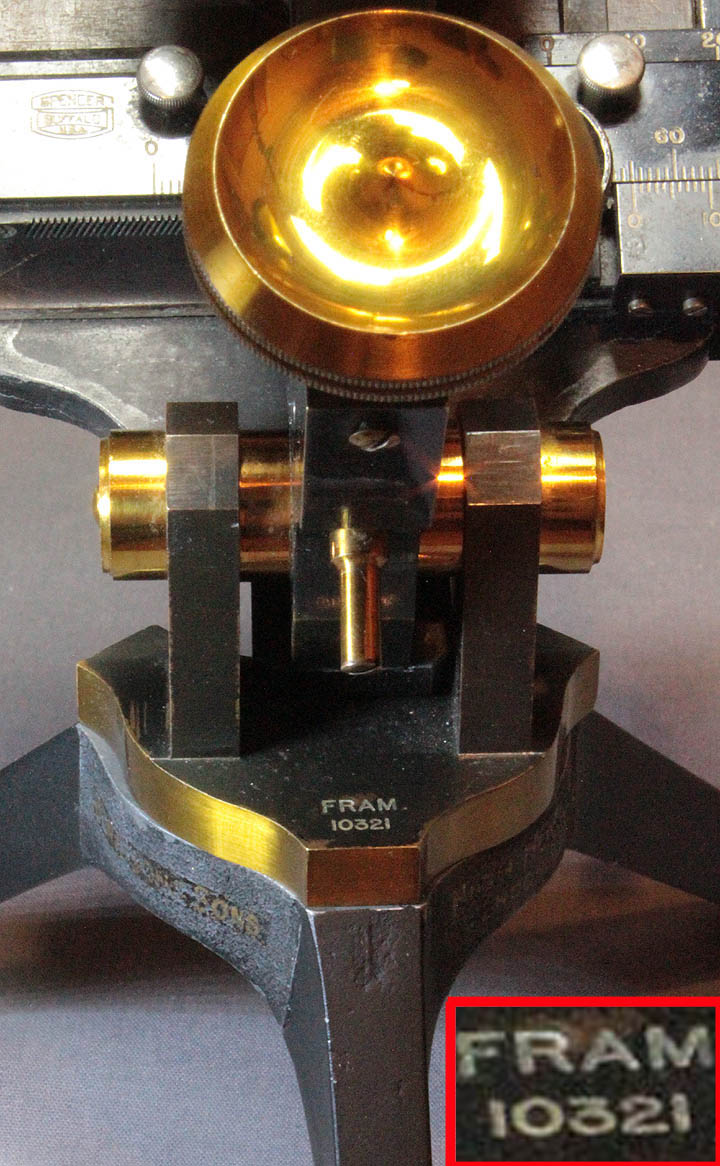 This compound microscope arises from a tripod of oxidized brass. The portion of the tripod beneath the lacquered brass plate is a single casting, and has nearly round toes but with flat inner edges. Screwed into the top of the tripod is a roughly heart-shaped brass plate with a lacquered brass edge. On the top surface of this plate is the engraving of the model, "FRAM" and under it, the serial number of 10321. From this plate arise two uprights to which the limb attaches by a trunnion joint. From the rear of the limb a rod protrudes which registers on the plate to stabilize the microscope in the horizontal position.
This compound microscope arises from a tripod of oxidized brass. The portion of the tripod beneath the lacquered brass plate is a single casting, and has nearly round toes but with flat inner edges. Screwed into the top of the tripod is a roughly heart-shaped brass plate with a lacquered brass edge. On the top surface of this plate is the engraving of the model, "FRAM" and under it, the serial number of 10321. From this plate arise two uprights to which the limb attaches by a trunnion joint. From the rear of the limb a rod protrudes which registers on the plate to stabilize the microscope in the horizontal position.
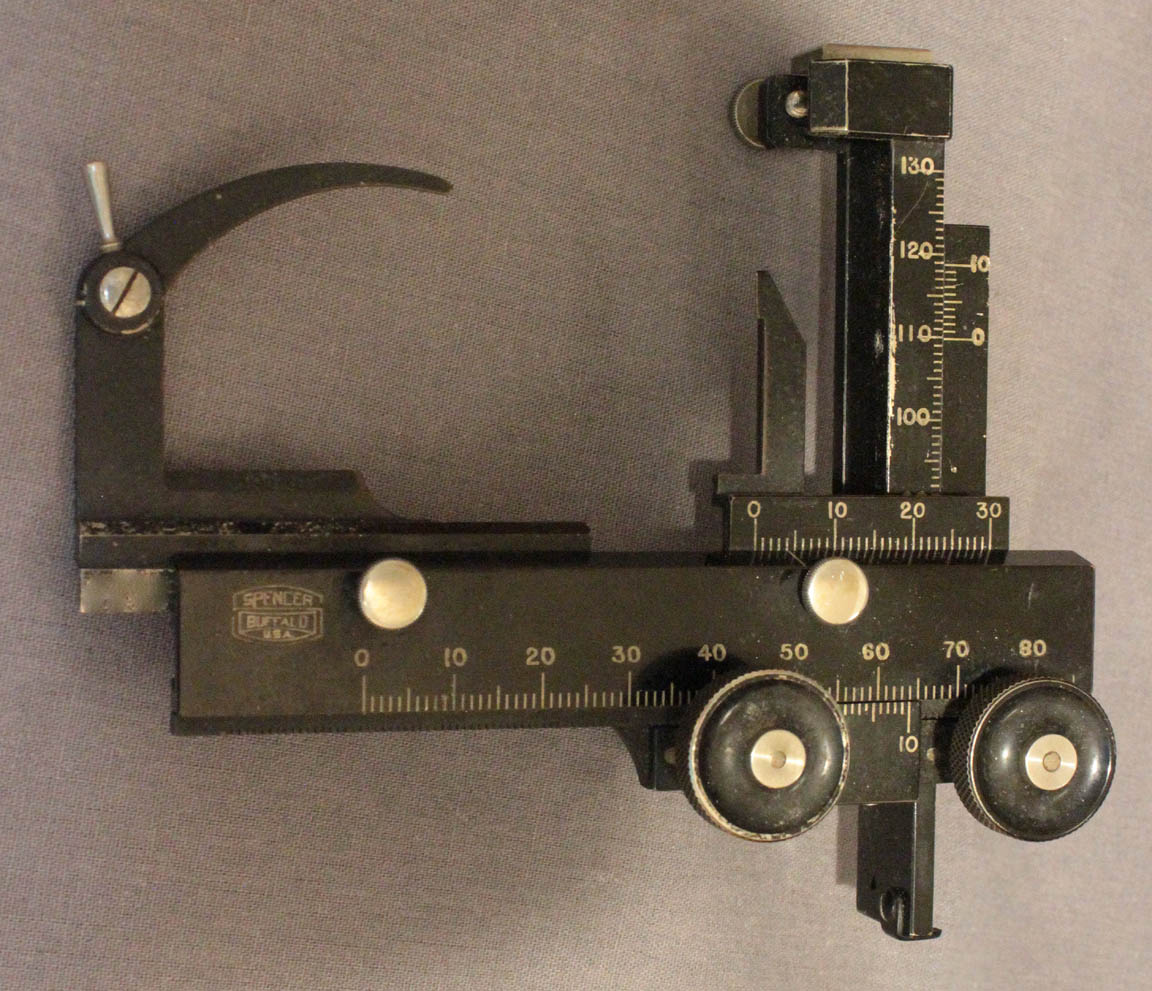 The stage is attached to the bottom edge of the limb via two heavy slotted screws. The stage is the type proposed by Nelson with a U-shaped cutout. the underside of this cutout has a round recess to allow the condenser to rise closer to the slide if needed. A Spencer mechanical stage(right) is attached by two knurled nickel or chrome knobs gripping the underside of the stage.
The stage is attached to the bottom edge of the limb via two heavy slotted screws. The stage is the type proposed by Nelson with a U-shaped cutout. the underside of this cutout has a round recess to allow the condenser to rise closer to the slide if needed. A Spencer mechanical stage(right) is attached by two knurled nickel or chrome knobs gripping the underside of the stage.
The substage is attached by a heavy slotted brass screw on the right side of the bottom of the stage (as viewed from underneath).
This allows the entire substage assembly to swing out of the optical axis. When turned into the optical axis, a C-shaped part of the substage assembly registers tightly on another heavy slotted screw. The substage has diagonal rack and pinion focusing by a single knurled knob
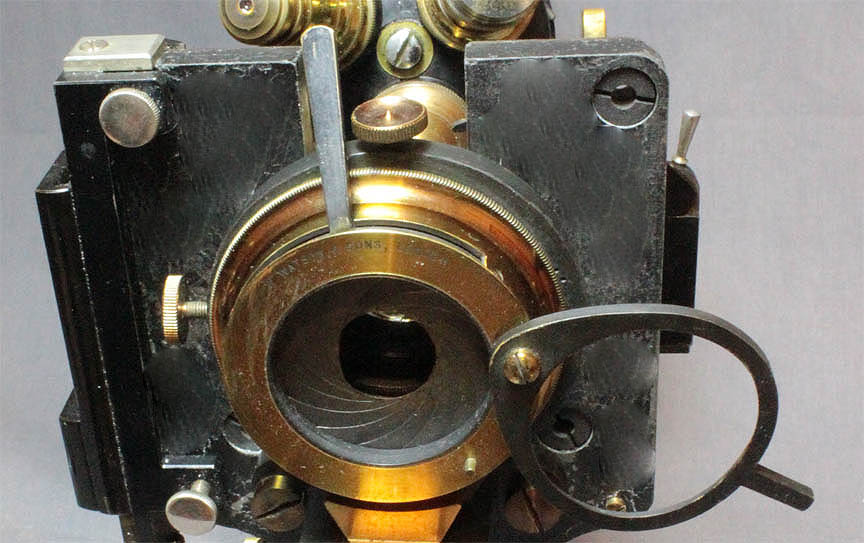
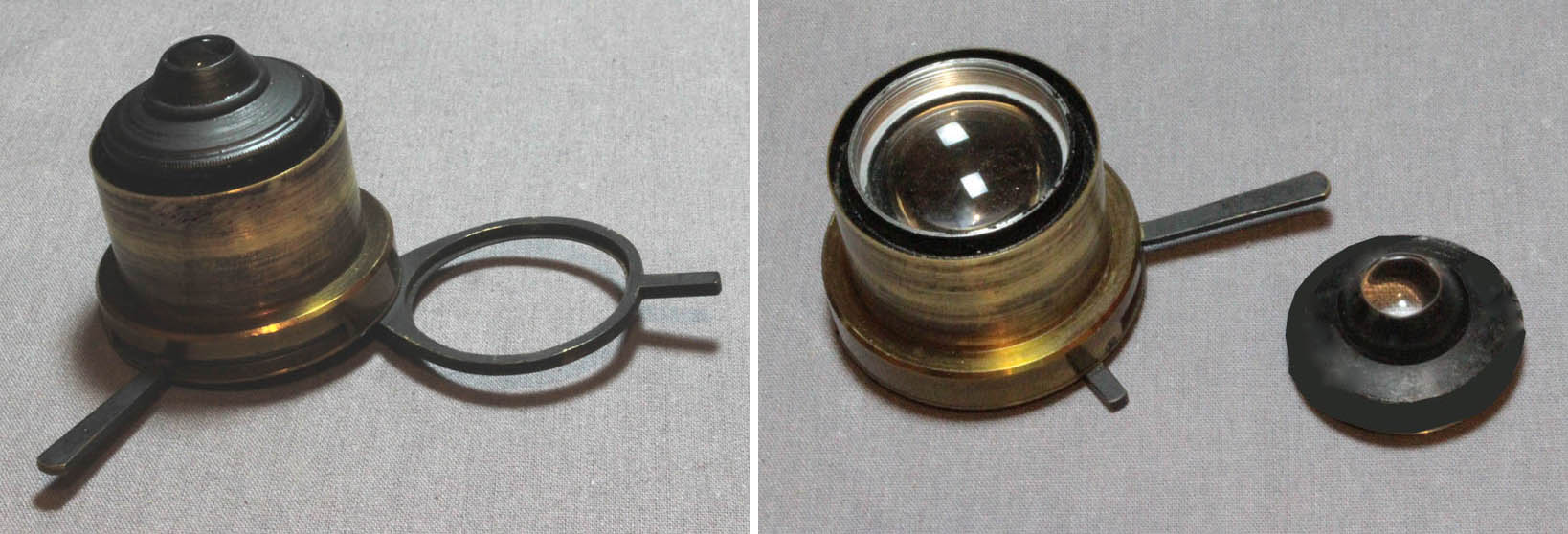
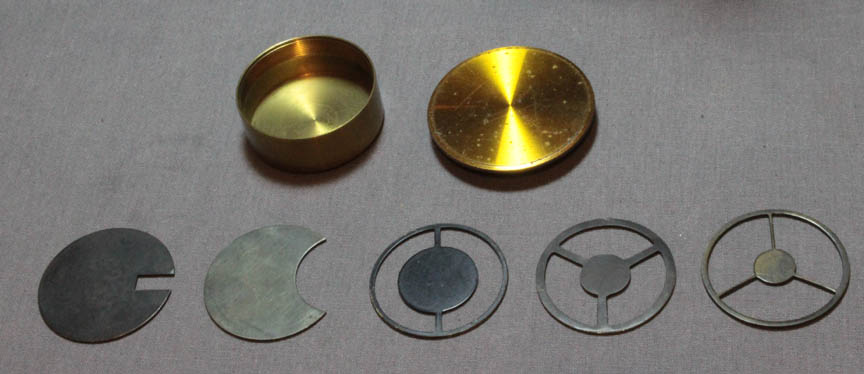 The substage ring has two knurled knobs for centering the condenser, which slides in from underneath. The condenser is signed on the bottom
The substage ring has two knurled knobs for centering the condenser, which slides in from underneath. The condenser is signed on the bottom W. WATSON & SONS LONDON
. A knurled edge of the removeable top element housing facilitates unscrewing to allow use of the remaining elements for low power. The condenser has an adjustable iris diaphragm and on the bottom is a swing-out filter holder for filters or stops for dark ground work.
The plane and concave mirrors are housed in a lacquered
brass casing attached to an oxidized brass gimbal. The mirror fitting slides up or down the tubular brass tailpiece which is attached to the bottom of the stage. Unlike some other examples, this tailpiece is fixed in the vertical position, perpendicular to the stage.
The instrument is signed in gold letters on the left side of the top of the tripod: W. WATSON & SONS
and on the right side: HIGH HOLBORN, LONDON
.
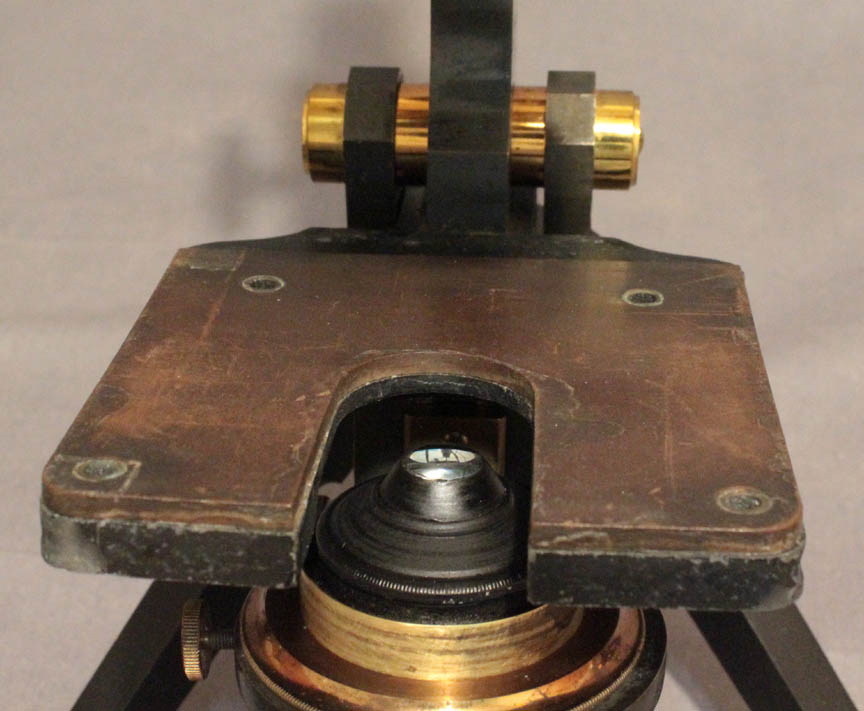 As shown to the left with the Spencer mechanical stage removed, the Stage of this model is a plain flat stage with vulcanite applied to the top. This is the Nelson form, with a U-shaped cutout. This form of stage was standard on this model from 1898 through 1913, but a solid stage with a central aperture was an option as well.
As shown to the left with the Spencer mechanical stage removed, the Stage of this model is a plain flat stage with vulcanite applied to the top. This is the Nelson form, with a U-shaped cutout. This form of stage was standard on this model from 1898 through 1913, but a solid stage with a central aperture was an option as well.
Coarse focus is by diagonal rack and spiral pinion while
the fine focus is via a long lever controlled from the top edge of the rear part of the arm. The knurled lacquered brass fine focus knob is not calibrated.
The outermost main optical tube is one and a half inch outside diameter and is about 5 and one half inches long. There is one brass calibrated drawtube. The draw tube is one inch in diameter and accepts the narrower 23 mm eyepieces. When fully extended, the mechanical tube length is about ten inches. The lacquered brass portion of the top of the drawtube is signed: AGENT, W.W. SCOTT & Co Ltd 180 SAOUHIEHALL ST., GLASGOW
. There is one eyepiece with the instrument signed 1
and a removeable black metal ring extends the edge above the top of the drawtube by .
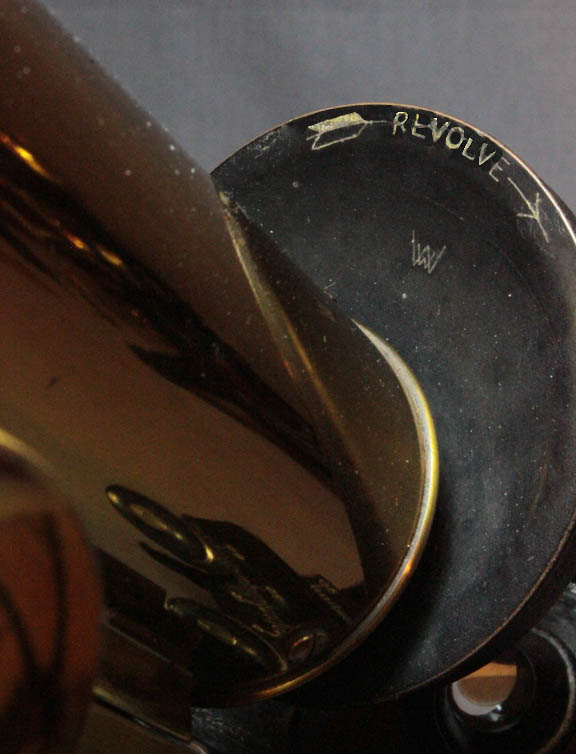 A Watson triple nosepiece obective changer is signed with the Watson double-W insignia and has an arrow indicating it should be rotated only clockwise as seen from above. The three objective positions are marked with the focal lengths of 2/3, 1/6 and 1/12 inches, the latter would be an oil immersion objective.
A Watson triple nosepiece obective changer is signed with the Watson double-W insignia and has an arrow indicating it should be rotated only clockwise as seen from above. The three objective positions are marked with the focal lengths of 2/3, 1/6 and 1/12 inches, the latter would be an oil immersion objective.
All the rack and pinion fittings have the capacity for
adjustment in the event of wear.
ACCESSORIES FOR THE WATSON
FRAM MICROSCOPE
Accessories currently with this microscope include the triple nosepiece, the attachable Spencer mechanical stage, three objectives, a single eyepiece and a Abbe-type substage condenser with a set of dark-ground and oblique stops for the swing-out filter holder. The triple nosepiece is labeled for three different magification objectives including 2 inch, 2/3 inch, and 1/6 inch. The eyepiece is labelled '1' and the condenser is signed as noted above. The condenser has an iris diaphragm in addition to the filter holder, and the housing for the top elements is knurled, allowing easy removal allowing the lower elements alone to be used for low power work.
Objectives with this microscope at this time include:
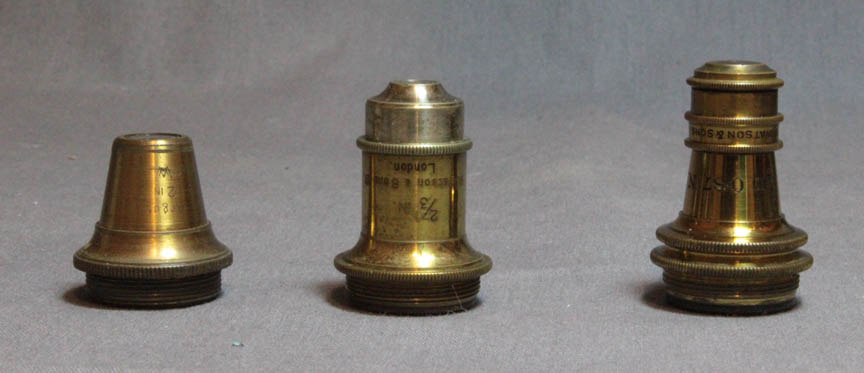
- A Watson Argus 2 inch (no can)
- A Watson & Sons Ltd 2/3 inch, N.A. 0.28 (no can)
- A Watson 1/6 inch,N.A. 0.67 (with original can)
CONDITION:
Every part of this microscope works like it did 100 years ago. The finish appears to be all original and nearly perfect.
COMPARISON WITH THE EDINBURGH H MODELS
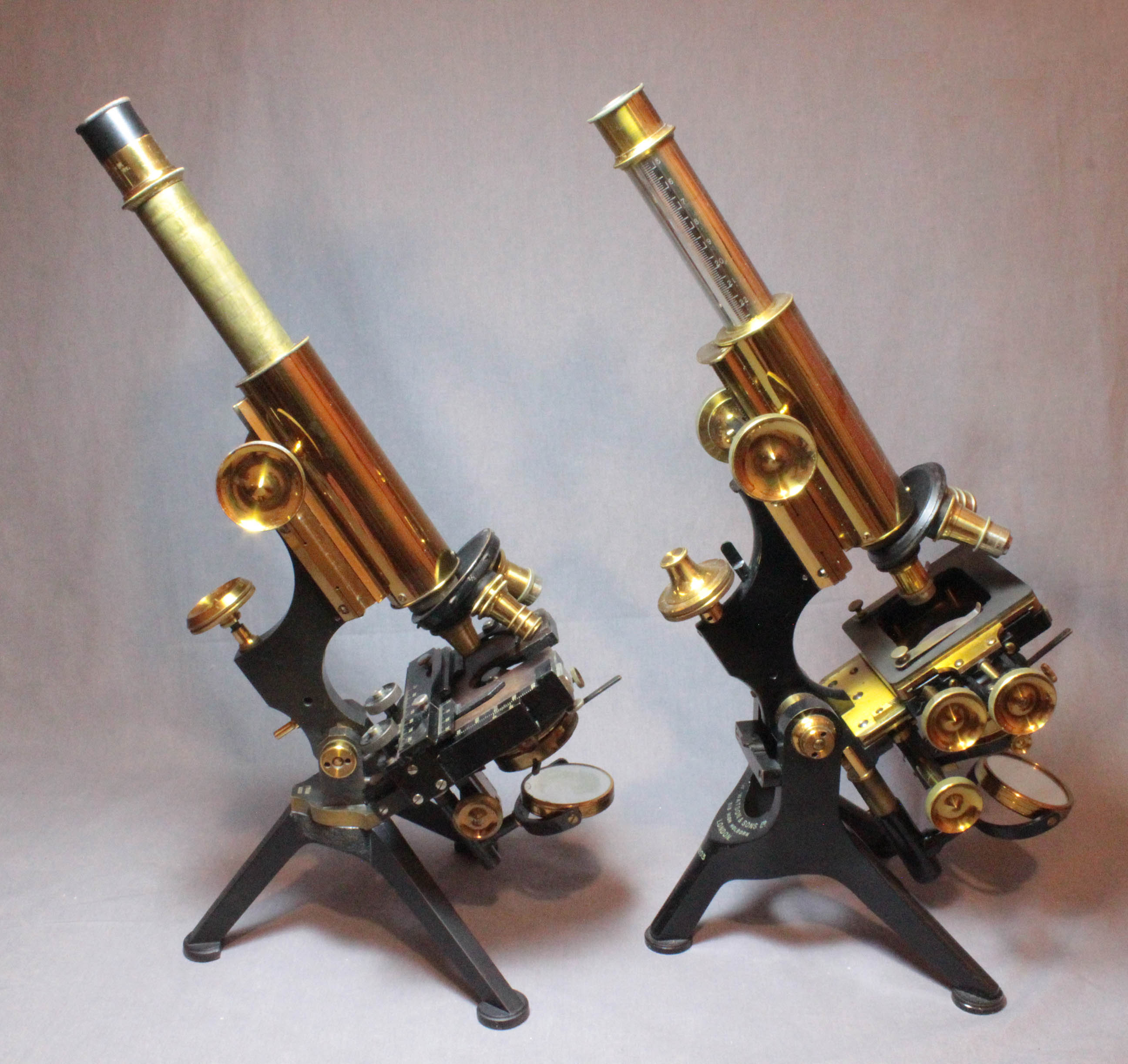 The Fram is not as hefty as the Edinburgh, but its size is roughly similar in outer dimensions, with the same size splay of the foot, and roughly the same height. The right to left splay of the foot of this Fram, 7 inches, is the same as the Edinburgh H. The height of the inclination joint is slightly shorter than the Edinburgh; the Fram is 4 5/8 inches vs the Edinburgh's 5 inches. Also note the Edinburgh has a nickel-plated draw tube while the Fram's is unlacquered brass.
The Fram is not as hefty as the Edinburgh, but its size is roughly similar in outer dimensions, with the same size splay of the foot, and roughly the same height. The right to left splay of the foot of this Fram, 7 inches, is the same as the Edinburgh H. The height of the inclination joint is slightly shorter than the Edinburgh; the Fram is 4 5/8 inches vs the Edinburgh's 5 inches. Also note the Edinburgh has a nickel-plated draw tube while the Fram's is unlacquered brass.
HISTORY AND EVOLUTION OF THE FRAM STUDENT MICROSCOPES
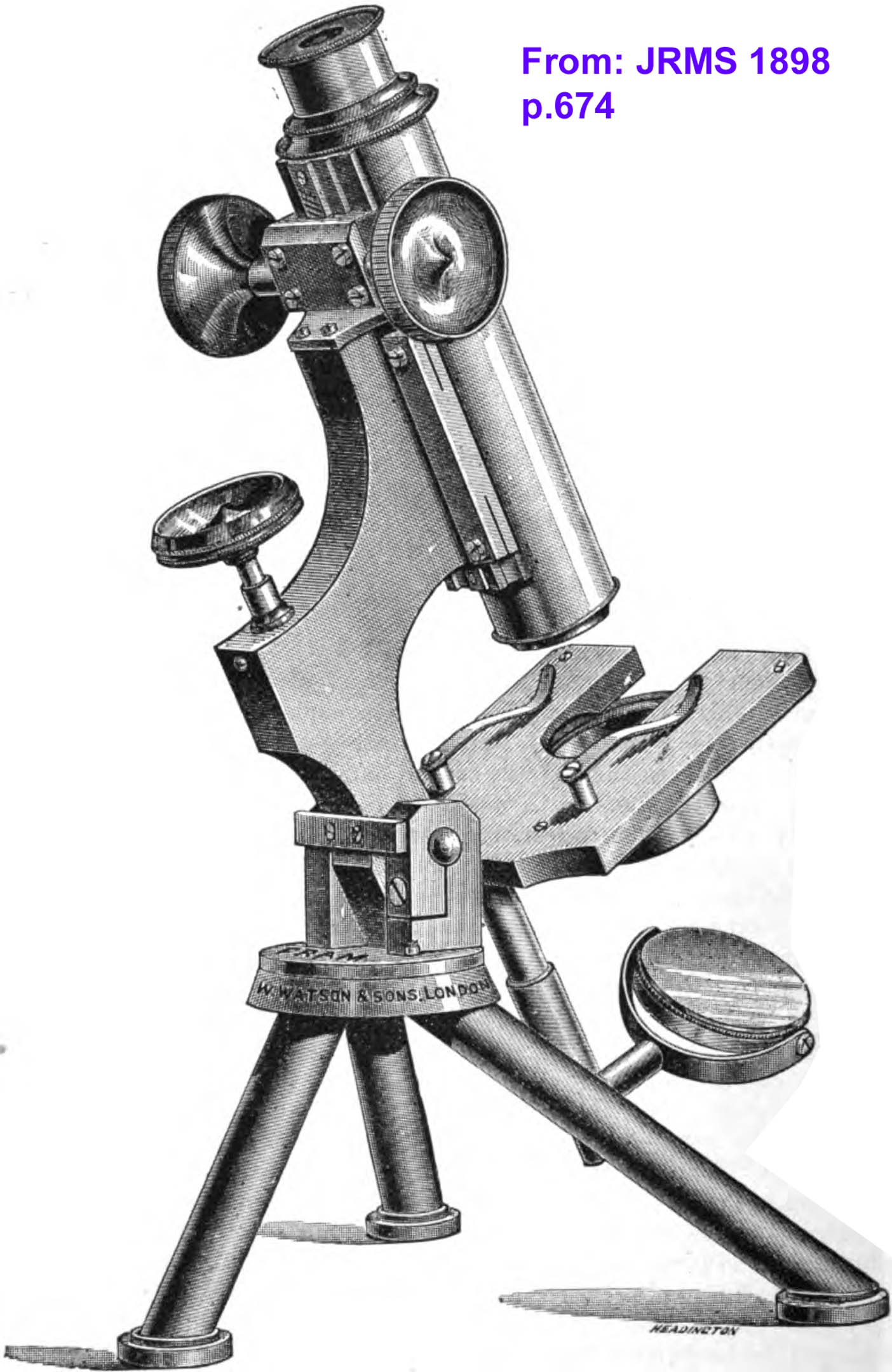
The Fram was an attempt at a slightly smaller and less expensive option than the earlier Edinburgh stand.
The Fram could eventually be equipped in a virtually identical way to the Edinburgh H stand. The Fram was first noted in the JRMS in 1898.
It was touted as a very good buy in many publications of the time, and truthfully, it is in my opinion an excellent microscope for the price. Changes in the Fram over time are mainly subtle changes in the construction of the tripod foot and an increasing number of options.
 The tripod originally (my type I) was composed of three oxidized solid brass tubular rods extending down from the underside of a circular oxidized-brass cap. These rods apparently fit into holes bored into the top of the tripod and were then soldered in place; a round lacquered brass top-cap was screwed on top of the oxidized one. Two uprights from the brass top cap extend upwards to support the inclination joint; inclination is stopped in the horizontal position by a brass peg, screwed into the limb. This type of foot was in use from 1898 to about 1902. From 1902 to about 1912, the design changed to my
The tripod originally (my type I) was composed of three oxidized solid brass tubular rods extending down from the underside of a circular oxidized-brass cap. These rods apparently fit into holes bored into the top of the tripod and were then soldered in place; a round lacquered brass top-cap was screwed on top of the oxidized one. Two uprights from the brass top cap extend upwards to support the inclination joint; inclination is stopped in the horizontal position by a brass peg, screwed into the limb. This type of foot was in use from 1898 to about 1902. From 1902 to about 1912, the design changed to my type II
, the type shown at the top of this web page. Starting about 1912 (my type III
), the tripod and its legs were all one casting. The three legs were now roughtly rectangular or heart shaped in cross-section. Some versions of this tripod were apparently made of a lightweight alloy, likely containing aluminum. A lacquered brass top-cap of the tripod was now roughly 'heart' shaped, and was screwed to the top of the tripod. The inclination joint was now of the same design as the Edinburgh. Starting about 1912, (my type III
), the tripod and uprights were all cast as a single solid piece of iron or steel, and the extra brass top cap was completely eliminated. It should be noted that the registration in the horizontal position of the inclination of the limb could be a pin projecting from the limb and resting on the top of the tripod, or, alternatively, the limb could rest on a small bar between the uprights, similar to the Edinburgh, Royal, and Van Heurcks. Both of these designs were used from 1898 through about 1912, after which only the bar type of limb rest was used.
By the time that my example was made, many options were available. These included an attachable mechanical stage, the spiral screw focusing substage as on my instrument, or even a rack and pinion substage with provision for centering (as on my instrument pictured at the top of this page), just like the Edinburgh H and Royal.
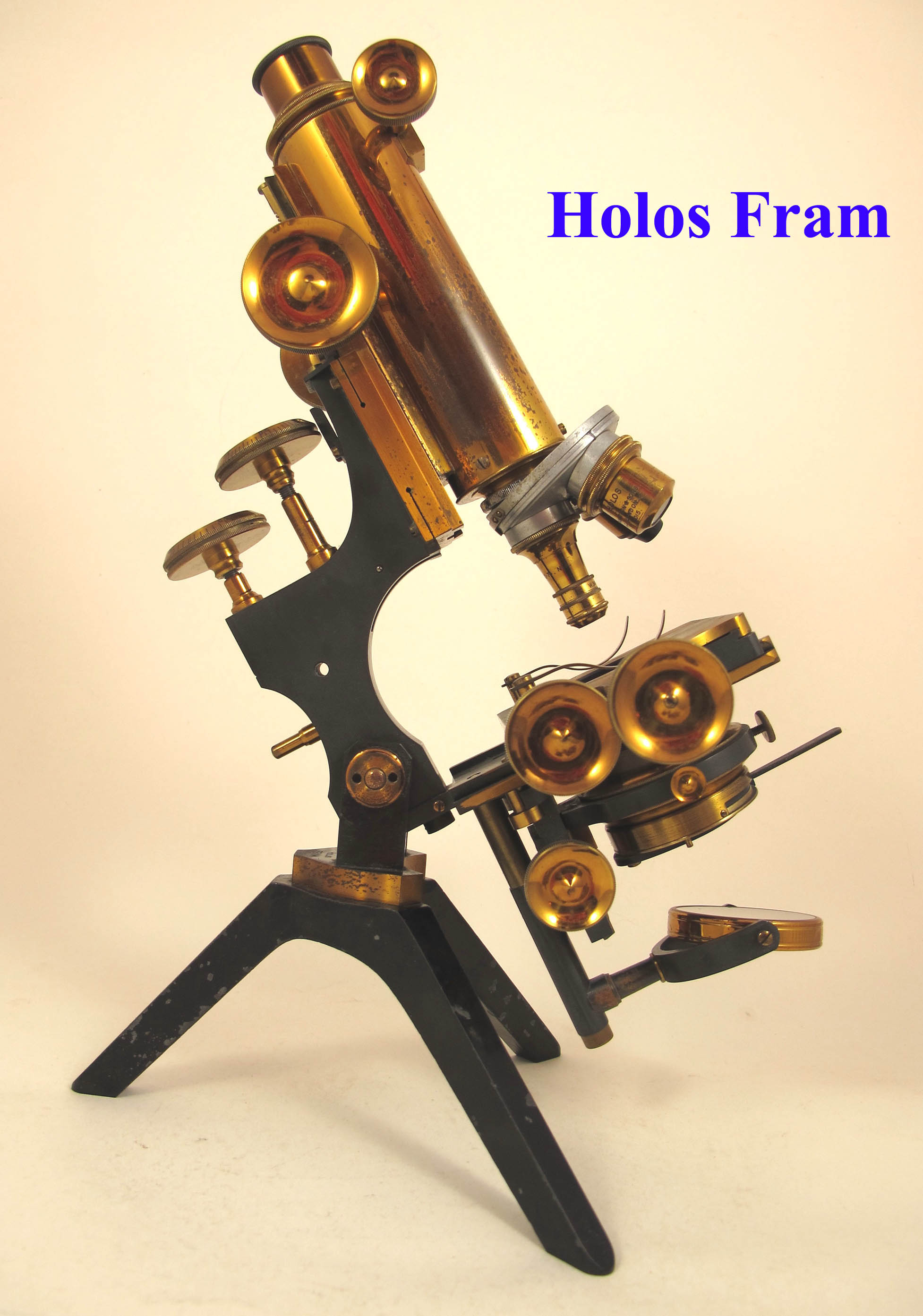 Noted for the first time in the JRMS in 1902, and also first
listed in the Watson 1902 catalog; the more deluxe 'Holos Fram'(left)
came standard with the same integral mechanical stage and substage as the Edinburgh H; it could even be ordered with a Males-Watson two speed fine adjustment and rack and pinion draw tube. In fact, as of 1902, any option offered for the Edinburgh H was available for the Fram or Holos Fram. A Holos Fram microscope, which was sold on Ebay in 2015, features the Males-Watson two speed fine adjustment with two fine focus knobs and a mechanical draw tube, as well as the standard built-in mechanical stage, making it very much a miniature, and more portable version of the Royal!
Noted for the first time in the JRMS in 1902, and also first
listed in the Watson 1902 catalog; the more deluxe 'Holos Fram'(left)
came standard with the same integral mechanical stage and substage as the Edinburgh H; it could even be ordered with a Males-Watson two speed fine adjustment and rack and pinion draw tube. In fact, as of 1902, any option offered for the Edinburgh H was available for the Fram or Holos Fram. A Holos Fram microscope, which was sold on Ebay in 2015, features the Males-Watson two speed fine adjustment with two fine focus knobs and a mechanical draw tube, as well as the standard built-in mechanical stage, making it very much a miniature, and more portable version of the Royal!
The author would like to acknowledge the help of Dr Joe Zeligs for his editorial skill and for his generosity in supplying some of the information on this page. I would also like to thank Richard Courtier, the former owner of the 'Holos Fram' shown here, for allowing me to reproduce his images. Finally I would like to thank Graham Marsh for his generous help in sorting out the construction of the Fram tripods, and other assistance and ideas he has given me since I first became interested in Watson microscopes.
 This compound microscope arises from a tripod of oxidized brass. The portion of the tripod beneath the lacquered brass plate is a single casting, and has nearly round toes but with flat inner edges. Screwed into the top of the tripod is a roughly heart-shaped brass plate with a lacquered brass edge. On the top surface of this plate is the engraving of the model, "FRAM" and under it, the serial number of 10321. From this plate arise two uprights to which the limb attaches by a trunnion joint. From the rear of the limb a rod protrudes which registers on the plate to stabilize the microscope in the horizontal position.
This compound microscope arises from a tripod of oxidized brass. The portion of the tripod beneath the lacquered brass plate is a single casting, and has nearly round toes but with flat inner edges. Screwed into the top of the tripod is a roughly heart-shaped brass plate with a lacquered brass edge. On the top surface of this plate is the engraving of the model, "FRAM" and under it, the serial number of 10321. From this plate arise two uprights to which the limb attaches by a trunnion joint. From the rear of the limb a rod protrudes which registers on the plate to stabilize the microscope in the horizontal position.  The stage is attached to the bottom edge of the limb via two heavy slotted screws. The stage is the type proposed by Nelson with a U-shaped cutout. the underside of this cutout has a round recess to allow the condenser to rise closer to the slide if needed. A Spencer mechanical stage(right) is attached by two knurled nickel or chrome knobs gripping the underside of the stage.
The stage is attached to the bottom edge of the limb via two heavy slotted screws. The stage is the type proposed by Nelson with a U-shaped cutout. the underside of this cutout has a round recess to allow the condenser to rise closer to the slide if needed. A Spencer mechanical stage(right) is attached by two knurled nickel or chrome knobs gripping the underside of the stage.

 The substage ring has two knurled knobs for centering the condenser, which slides in from underneath. The condenser is signed on the bottom
The substage ring has two knurled knobs for centering the condenser, which slides in from underneath. The condenser is signed on the bottom  As shown to the left with the Spencer mechanical stage removed, the Stage of this model is a plain flat stage with vulcanite applied to the top. This is the Nelson form, with a U-shaped cutout. This form of stage was standard on this model from 1898 through 1913, but a solid stage with a central aperture was an option as well.
As shown to the left with the Spencer mechanical stage removed, the Stage of this model is a plain flat stage with vulcanite applied to the top. This is the Nelson form, with a U-shaped cutout. This form of stage was standard on this model from 1898 through 1913, but a solid stage with a central aperture was an option as well.  A Watson triple nosepiece obective changer is signed with the Watson double-W insignia and has an arrow indicating it should be rotated only clockwise as seen from above. The three objective positions are marked with the focal lengths of 2/3, 1/6 and 1/12 inches, the latter would be an oil immersion objective.
A Watson triple nosepiece obective changer is signed with the Watson double-W insignia and has an arrow indicating it should be rotated only clockwise as seen from above. The three objective positions are marked with the focal lengths of 2/3, 1/6 and 1/12 inches, the latter would be an oil immersion objective.  The Fram is not as hefty as the Edinburgh, but its size is roughly similar in outer dimensions, with the same size splay of the foot, and roughly the same height. The right to left splay of the foot of this Fram, 7 inches, is the same as the Edinburgh H. The height of the inclination joint is slightly shorter than the Edinburgh; the Fram is 4 5/8 inches vs the Edinburgh's 5 inches. Also note the Edinburgh has a nickel-plated draw tube while the Fram's is unlacquered brass.
The Fram is not as hefty as the Edinburgh, but its size is roughly similar in outer dimensions, with the same size splay of the foot, and roughly the same height. The right to left splay of the foot of this Fram, 7 inches, is the same as the Edinburgh H. The height of the inclination joint is slightly shorter than the Edinburgh; the Fram is 4 5/8 inches vs the Edinburgh's 5 inches. Also note the Edinburgh has a nickel-plated draw tube while the Fram's is unlacquered brass.

 The tripod originally (my type I) was composed of three oxidized solid brass tubular rods extending down from the underside of a circular oxidized-brass cap. These rods apparently fit into holes bored into the top of the tripod and were then soldered in place; a round lacquered brass top-cap was screwed on top of the oxidized one. Two uprights from the brass top cap extend upwards to support the inclination joint; inclination is stopped in the horizontal position by a brass peg, screwed into the limb. This type of foot was in use from 1898 to about 1902. From 1902 to about 1912, the design changed to my
The tripod originally (my type I) was composed of three oxidized solid brass tubular rods extending down from the underside of a circular oxidized-brass cap. These rods apparently fit into holes bored into the top of the tripod and were then soldered in place; a round lacquered brass top-cap was screwed on top of the oxidized one. Two uprights from the brass top cap extend upwards to support the inclination joint; inclination is stopped in the horizontal position by a brass peg, screwed into the limb. This type of foot was in use from 1898 to about 1902. From 1902 to about 1912, the design changed to my  Noted for the first time in the JRMS in 1902, and also first
listed in the Watson 1902 catalog; the more deluxe 'Holos Fram'(left)
came standard with the same integral mechanical stage and substage as the Edinburgh H; it could even be ordered with a Males-Watson two speed fine adjustment and rack and pinion draw tube. In fact, as of 1902, any option offered for the Edinburgh H was available for the Fram or Holos Fram. A Holos Fram microscope, which was sold on Ebay in 2015, features the Males-Watson two speed fine adjustment with two fine focus knobs and a mechanical draw tube, as well as the standard built-in mechanical stage, making it very much a miniature, and more portable version of the Royal!
Noted for the first time in the JRMS in 1902, and also first
listed in the Watson 1902 catalog; the more deluxe 'Holos Fram'(left)
came standard with the same integral mechanical stage and substage as the Edinburgh H; it could even be ordered with a Males-Watson two speed fine adjustment and rack and pinion draw tube. In fact, as of 1902, any option offered for the Edinburgh H was available for the Fram or Holos Fram. A Holos Fram microscope, which was sold on Ebay in 2015, features the Males-Watson two speed fine adjustment with two fine focus knobs and a mechanical draw tube, as well as the standard built-in mechanical stage, making it very much a miniature, and more portable version of the Royal!